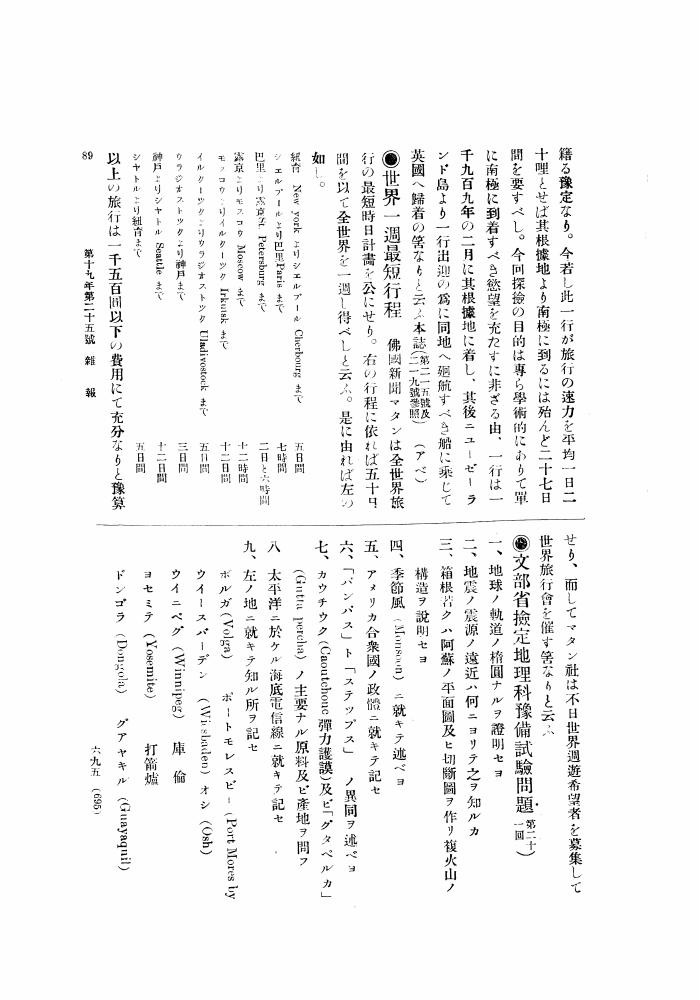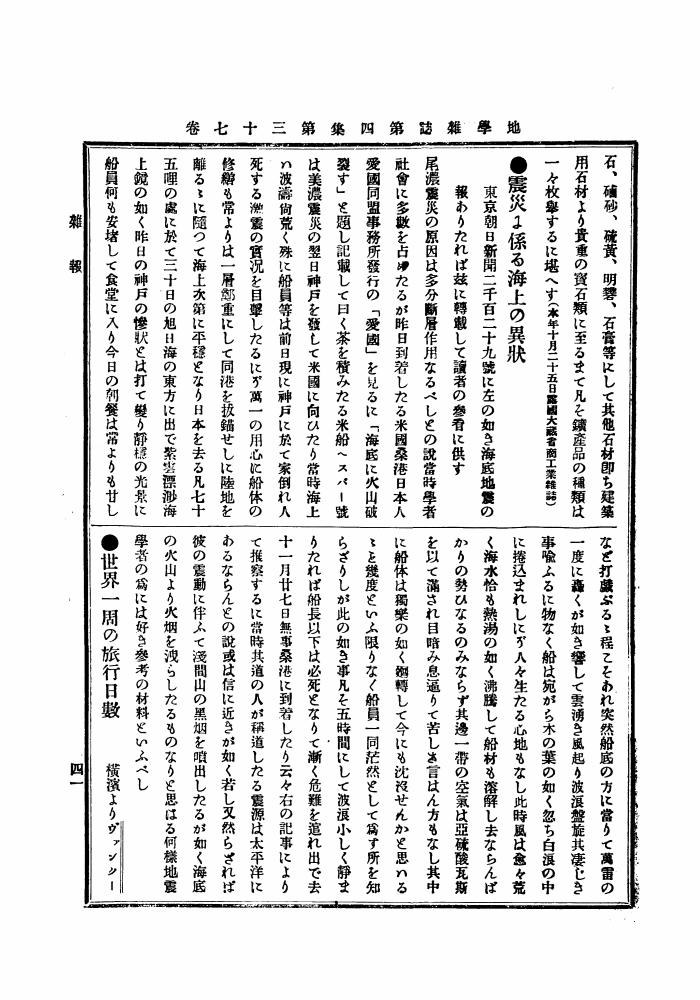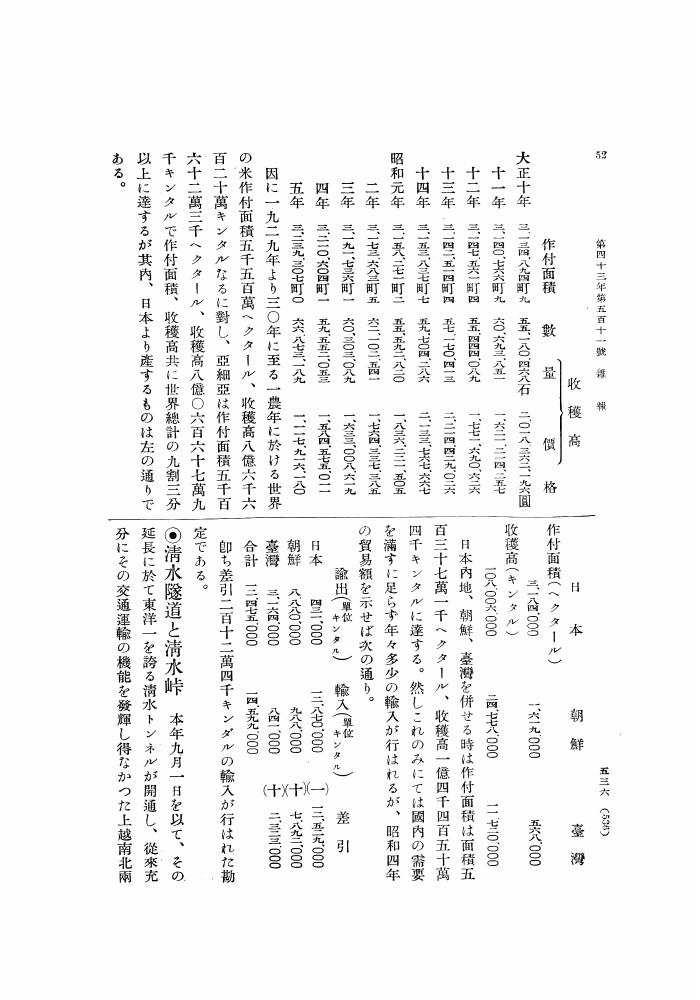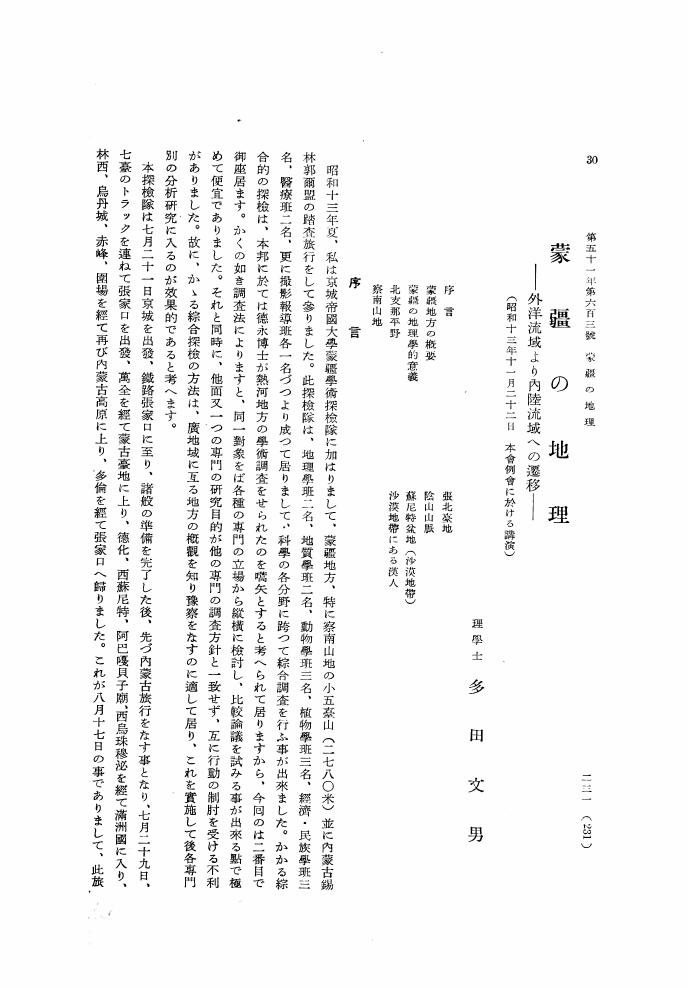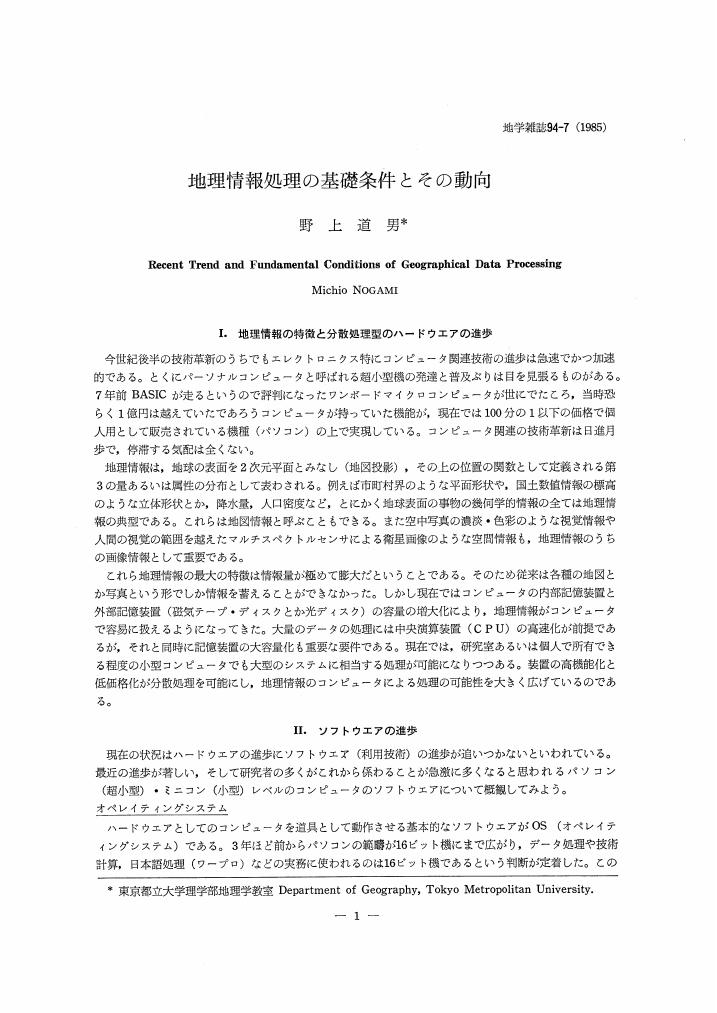1 0 0 0 OA 津波による人的被害の地域差はなぜ生じたのか
- 著者
- 高橋 誠 松多 信尚
- 出版者
- 公益社団法人 東京地学協会
- 雑誌
- 地学雑誌 (ISSN:0022135X)
- 巻号頁・発行日
- vol.124, no.2, pp.193-209, 2015-04-25 (Released:2015-05-14)
- 参考文献数
- 18
- 被引用文献数
- 6 6
Generally, the impacts of a tsunami can be understood in terms of the corresponding relationships between hazard scale and extent of building damage and loss of human life. Focusing on community-scale statistics of the municipalities of Kamaishi, Kesen'numa, Minami-sanriku, and Yamamoto, which were severely affected by the 2011 Tohoku Earthquake, significant variations are observed in the mortality rates at affected villages that experienced the same levels of building damage. Moreover, differences in the geographical locations of the villages also impact their mortality rates. A village with a high mortality rate is situated either on a coastal plain or on an inland valley plain some distance from the sea, whereas a village with a low mortality rate is paradoxically in close proximity to the sea, often facing a small bay. Close interrelationships are identified among geographical conditions and possible evacuation activities, which relate to the geographical imaginations of inhabitants based on their inherent local knowledge and interactions with physical and built environments. Interviews with survivors indicate decisions to escape could not be made quickly after the earthquake occurred. Rather, people were confused regarding the occurrence and magnitude of the tsunami and the provision of evacuation sites. The tsunami waves were often different from those that were formally forecast and broadcast, which compelled people to act flexibly. Consequently, it is argued that it is necessary to emphasize the effects of local geographies on interactions between tsunami waves and evacuation activities from a grassroots perspective when preparing for future tsunamis.
1 0 0 0 OA テクトニクスに関連する非火山性温泉の地球化学的特徴
- 著者
- 益田 晴恵
- 出版者
- 公益社団法人 東京地学協会
- 雑誌
- 地学雑誌 (ISSN:0022135X)
- 巻号頁・発行日
- vol.132, no.1, pp.1-16, 2023-02-25 (Released:2023-03-09)
- 参考文献数
- 53
- 被引用文献数
- 3
Occurrences of non-volcanic hot and mineral spring waters, found in Niigata and the surrounding areas, as well as central to southern Kinki District, are documented in relation to the local tectonics to discuss on the importance of plate tectonics as sources of heat and dissolved chemical compositions in the deep groundwater/fluid cycle. Fossil seawater was altered at different temperatures, and remains as low-temperature mineral waters in Gunma Prefecture, and as oil and gas field brine and related hot springs in Niigata Prefecture and surrounding areas. One of the hot springs in Niigata, i.e., Matsunoyama Hot Spring, is known to contain geo-pressure hydrothermal water. The brines in Niigata Prefecture are heated via tectonics at the boundary between the Eurasian and North-American plates without contaminating modern local meteoric water. In the Kinki District, hot spring waters > 40°C appear only in three regions: coastal area along the Sea of Japan, Arima and surrounding area of Osaka Basin, and southern part of Kii Peninsula. In this area, mantle-derived fluids, such as He and CO2, are upwelling with slab-derived saline waters from the subducting Philippine Sea Plate. Non-volcanic hot spring waters occasionally give the important information on heat and energy cycles at the plate boundaries, as well as valuable information for understanding the mechanisms of inland earthquakes related to the deep-fluid movements.
1 0 0 0 OA フィリピン海の海底地形
- 著者
- 茂木 昭夫
- 出版者
- Tokyo Geographical Society
- 雑誌
- 地学雑誌 (ISSN:0022135X)
- 巻号頁・発行日
- vol.79, no.5, pp.243-265, 1970-10-25 (Released:2009-11-12)
- 参考文献数
- 47
- 被引用文献数
- 6 6
The Philippine Sea is bounded on the west by the southern half of Japan, the Ryukyu Islands and the Philippines, and on the east by the arcuate seafloor ridge extending from Japan to the Palau Islands through the Mariana Islands. Both arcuate structures are associated with deep sea trench, island arcs, volcanic activity, deep focus earthquakes and negative gravity anomalies. This abyssal deep basin which consists of the oceanic crust is separated into the east and the west basin by the Kyushu-Palau Ridge. The east basin is somewhat shoaler, and can be divided by the central narrow zone at 23°N into two parts, Shikoku Basin and West Mariana Basin, which gradually rise toward the Honshu-Mariana Ridge. There are, however, several seamounts, called the Kinan Seamount Chain, arranged in NNW-SSE direction in the Shikoku Basin. And on its southern extension, there are several troughs, called the West Mariana Trough, arranged is N-S direction. The Shikoku Basin is composed of the smooth floor of the northeastern part and the mountainous area of the southwestern part. The West Mariana Basin is also divided into the abyssal plain on the east and abyssal hill region on the west. And the West Mariana Trough is running on its boundary.The west basin, Philippine Basin, is unusually deep. A region of rugged topography which can be termed the Daito Ridges lies at the northernmost part of the basin. These several parallel ridges elongate from the respective coral islands to southeastward intervening narrow depressions. There are flat plains at the depth of about 1500, 2000 and 3000 m on the northern side of each of the ridges. There is the striking feature, called Central Basin Fault, in the central part of the Philippine Basin. Central Basin Fault which is the low ridge associated with trough in the NW-SE direction separate the Philippine Basin into the north basin and the south basin. On the Philippine Basin floor, the most extensive area is abyssal hill region. Abyssal plains are developed only in limited localities such as the west side of the northern arc of the Kyushu-Palau Ridge.From the description on the submarine topography of the Philippine Sea the author concluded as follows.(1) A few ridges and seamounts not associated with trench are running parallel to the Ryukyu-Philippine Arc and Izu-Mariana Arc : one Kyushu-Palau Ridge, two Kinan Seamount Chain-West Mariana Trough, three Nishi-Shichito Ridge-West Mariana Ridge. These ridges close the space eastward. And basements of basins which intervened between each ridges rise toward the east.(2) There are another ridges having unusual trend. The Daito Ridges have E-W trend and the minor ridges on the Izu Ridge have the NE-SW trend.The numerous minor ridges which construct the abyssal hill region also have the E-W trend on the northern part of the Philippine Sea, although its trend changes to the N-S trend southward gradually. These trends are correspond to the Southwest Japan Arc.(3) Ridges with E-W trend are cut by the ridges with N-S trend, alike the Japan Arc crossed by the Izu-Mariana arc.(4) Kyushu-Palau Ridge consists of two arcs, northern arc parallel to the Ryukyu Arc and southern arc parallel to the Philippine Arc. These two arcs are separated by the Central Basin Fault. Another possible fault runs from the depression in the east side of the northern Kyushu-Palau Ridge to the junction of the Izu-Ogasawara Arc and the Mariana Arc. The southern arc (Mariana) remarkably projects to the southeast along this fault.(5) Abyssal hill provinces in the Philippine Sea occupy the western half of each basins usually. Some of the flat plains occupying the eastern half appear to the archipelagic apron which is constructed by the eruption on the concave side flank of the arcuate ridges.
1 0 0 0 OA 山の高さを測る話
- 著者
- 鈴木 弘道
- 出版者
- 公益社団法人 東京地学協会
- 雑誌
- 地学雑誌 (ISSN:0022135X)
- 巻号頁・発行日
- vol.103, no.5, pp.595-596, 1994-10-25 (Released:2009-11-12)
- 参考文献数
- 1
1 0 0 0 OA 世界一週の電信時
- 出版者
- 公益社団法人 東京地学協会
- 雑誌
- 地学雑誌 (ISSN:0022135X)
- 巻号頁・発行日
- vol.8, no.8, pp.432a, 1896-08-10 (Released:2010-12-22)
1 0 0 0 OA 世界一週旅行后數
- 出版者
- 公益社団法人 東京地学協会
- 雑誌
- 地学雑誌 (ISSN:0022135X)
- 巻号頁・発行日
- vol.9, no.7, pp.333a-334, 1897-07-15 (Released:2010-12-22)
1 0 0 0 OA 世界一週最短行程
- 出版者
- 公益社団法人 東京地学協会
- 雑誌
- 地学雑誌 (ISSN:0022135X)
- 巻号頁・発行日
- vol.19, no.9, pp.695, 1907-09-15 (Released:2010-12-22)
1 0 0 0 OA 九十日間世界一週
- 出版者
- 公益社団法人 東京地学協会
- 雑誌
- 地学雑誌 (ISSN:0022135X)
- 巻号頁・発行日
- vol.1, no.6, pp.264, 1889-06-25 (Released:2010-12-22)
1 0 0 0 OA 八日と十六時間で世界一周飛行
- 出版者
- 公益社団法人 東京地学協会
- 雑誌
- 地学雑誌 (ISSN:0022135X)
- 巻号頁・発行日
- vol.43, no.11, pp.661a-662, 1931-11-15 (Released:2010-12-22)
1 0 0 0 OA 世界一周の族行日數
- 出版者
- 公益社団法人 東京地学協会
- 雑誌
- 地学雑誌 (ISSN:0022135X)
- 巻号頁・発行日
- vol.4, no.1, pp.41a-42, 1892-01-25 (Released:2010-12-22)
1 0 0 0 OA 1950~1年三原山噴火の活動状況と研究陣展望
- 著者
- 諏訪 彰
- 出版者
- Tokyo Geographical Society
- 雑誌
- 地学雑誌 (ISSN:0022135X)
- 巻号頁・発行日
- vol.60, no.3, pp.107-114, 1951-09-30 (Released:2009-11-12)
The writer intended here to sketch in broad outline the eruption of Mt. Miharayama, on the island of Oshima, and to have a general view of the works of Japanese volcanologists with reference to the eruption.The eruption was one of·the greatest activities of the volcano in the historical time, characterized by frequent explosions of the Strombolian type.A summit eruption took place suddenly on July 16, 1950, ejecting ash and lava fragments and welling out molten lava, and continued without interruption until September 23. Besides, the volcanic activity resumed on February 4, 1951, and continued incessantly until about the end of March, but it declined and became intermittent at the beginning of April and was completely dead on July 28.During the eruption, a large quantity of new lava flowed out over the rim of the central cone after an interval of 172 years.Nearly one hundred able volcanologists In our country made various invaluable studies on the eruption from geophysical, geochemical, geological and petrological viewpoints.Moreover, the eruption went a long way toward the popularization of scientific knowledge on the volcano and its activity.
1 0 0 0 OA 根室アイヌにおける家構成員の流動性のメカニズム
- 著者
- 遠藤 匡俊
- 出版者
- Tokyo Geographical Society
- 雑誌
- 地学雑誌 (ISSN:0022135X)
- 巻号頁・発行日
- vol.105, no.5, pp.590-612, 1996-10-25 (Released:2009-11-12)
- 参考文献数
- 63
- 被引用文献数
- 2 1
Many old documents show that the Ainu in the Edo period (1603-1867), who were fishers, hunters and gatherers, were a migratory people. It is also widely accepted that the Ainu moved seasonally from their home residences. This probably indicates that the residents of these settlements were relatively stable. But a detailed analysis of other documents shows that two types of mobility were found in Ainu society : inter-settlement movement of households and inter-household movement of the inhabitants. In the Takashima district during the years 1834-1871, the high death rate was the main cause for inter-household movement of the inhabitants. This type of mobility is entitled “Coping Mobility”.The purpose of this paper is to show that during the years 1848-1858 the composition of households in the Nemuro district of Hokkaido varied as a result of inter-household movement of its members, and the main cause for the high mobility was not the high death rate but the high divorce rate.In the Nemuro district, the population of the Ainu decreased dramatically between 1848 and 1852, and then it increased between 1852 and 1858 (Figs. 1 and 2). Their life had already changed depending less on fishing, hunting, and gathering, under the influence of the Wajin. Most permanent residences were located within the same settlements (Fig. 3), but many resident members moved between households (Fig. 4). The number of persons per 100 inhabitants during a 10-year period who moved between households was very large, especially in the Nemuro district and also in the Takashima and Monbetsu districts. But the number was much smaller in the Mitsuishi and Shizunai districts and the southwestern part of Sakhalin (Table 1). The stability of the household members was much lower in the Nemuro, Takashima and Monbetsu districts than in the Shizunai district and the southwestern part of Sakhalin (Fig. 5).Four factors were recognized as main causes for the movement of household members : (1) the death of a spouse, (2) the death of someone other than a spouse, (3) the divorce of amarried couple, and(4) the separation of someone other than a spouse (Fig.8).About 81% (510/631) of the total number of persons who moved between households did so owing to these four reasons. When we include the cases where people moved for two or more reasons, about 68% (349/510) moved because of divorce, and about 94% (481/510) moved because of the divorce and/or the death of a spouse. Persons who moved between households owing to divorce moved individually in most cases, rarely together. When they moved together, they were in most cases unmarried children and their mother (Table 5). About 54 % of the men divorced between the ages of 20 and 34, and about 62% of the women divorced between the ages of 15 and 34 (Fig. 9). The rate of divorce was much higher in the Nemuro district than in the Takashima, Monbetsu, and Shizunai districts and in the southwestern part of Sakhalin (Table 7).The typical pattern of mobility among households is as follows. After a married couple divorced, the former wife moved to another household, usually by herself, sometimes the children would accompany her (sometimes the children would move with the father). In many cases the divorced persons moved to another household to remarry. When they did not move for marriage purposes, they moved to the households where their siblings, fathers and/ or mothers dwelled. This was the first move for the unmarried children. When the unmarried children grew up, they might move to another household for their own marriage. This would be their second move. Then if they divorced, they would move to a third household. In the Nemuro district the inter-household movement of the inhabitants is regarded to have been caused by the high divorce rate. This type of mobility is entitled “Preparative Mobility”.
1 0 0 0 OA プヰプヰアン、ド、サン、マルタンの傳
- 著者
- 鐵椎 學人
- 出版者
- 公益社団法人 東京地学協会
- 雑誌
- 地学雑誌 (ISSN:0022135X)
- 巻号頁・発行日
- vol.16, no.3, pp.203-205, 1904-03-15 (Released:2010-10-13)
1 0 0 0 OA 伊豆・小笠原弧北部域の明神海丘における海底カルデラの形成機構
- 著者
- 村上 文敏
- 出版者
- Tokyo Geographical Society
- 雑誌
- 地学雑誌 (ISSN:0022135X)
- 巻号頁・発行日
- vol.106, no.1, pp.70-86, 1997-02-25 (Released:2009-11-12)
- 参考文献数
- 24
- 被引用文献数
- 6 6
Myojin Knoll Caldera is located on the broad volcanic edifice of Myojin Knoll and is one of the twelve calderas along the front of the Izu-Ogasawara (Bonin) Arc. The caldera floor is about 3×4 km in diameter and lies at a depth of about 1, 400 m.Myojin Knoll is composed of three acoustically defined stratigraphic units, 1A, 1B, and 1C. These are correlated respectively with three lithologic units : stratified volcanic breccia, massive volcanic breccia and rhyolitic lava. These same lithologies were observed during submersible dives using Shinkai 2000. The volume of these units making up Myojin Knoll is Unit1A, 17.5 km3; Unit 1B, 64 km3; and Unit 1C, 48.3 km3.The mean density of Myojin Knoll is about 1.84 g/cm3, based on the calculated volumes and assumed densities of Unit 1A, 1B, and 1C. Using this density for Bouguer corrections, there is neither a high nor a low Bouguer anomaly associated with the caldera. This pattern is more typical of anomalies associated with volcanic craters rather than with Krakatau-type calderas. Three dipole type magnetic anomalies have been recognized, one on the north caldera rim, another on the west rim, and a third on the central cone. The anomaliy associated with the central cone is small, reflecting its relatively small volume.Three mechanisms are suggested for the formation of the Myojin Knoll Caldera : (1) the caldera formed as a pumice cone, (2) it formed by collapse of the pre-caldera stratovolcano that formed Units 1B and 1C, and (3) it formed by the destruction of the pre-caldera stratovolcano as a result of the explosive eruption of the huge volume of pumice associated with Unit 1A. The gravity and magnetic data presented here suggest that the models of the pumice cone and the explosive destruction of the pre-caldera stratovolcano are preferable to the model of a collapsing stratovolcano.
1 0 0 0 OA 東京臨海部における港湾再開発と土地利用変化の特性 ―東京都港区海岸地区を事例に―
- 著者
- 太田 慧
- 出版者
- 公益社団法人 東京地学協会
- 雑誌
- 地学雑誌 (ISSN:0022135X)
- 巻号頁・発行日
- vol.124, no.4, pp.525-544, 2015-08-25 (Released:2015-09-17)
- 参考文献数
- 24
Changing land use patterns are clarified from time and space points of view. Relationships are revealed between changing land-use patterns and port functions in the Kaigan area of the Tokyo waterfront, Minato Ward, Tokyo Metropolis. After Tokyo port opened in 1941, the Tokyo waterfront area was used mainly for logistics facilities, such as warehouses and port facilities. However, since the 1960s, the logistics system in the port has been changed by containerization. Port facilities in the Tokyo waterfront area became outdated. In response, the Tokyo waterfront area was redeveloped in the mid-1980s. As a result, significant changes to land use occurred in the Tokyo waterfront area. This study selects three target years, 1985, 1996, and 2012. A mesh analysis is conducted of land use in the Kaigan area, Minato Ward, Tokyo district. From 1985 to 1996, the port policy changed land use in the port district away from logistics facilities, including warehouses and port facilities. From 1985 to 1996, vacant land for redevelopment increased during the period of the asset inflation-led bubble economy. In comparison with the period from 1985 to 1996, during the period of from 1996 to 2012, land use changes in the port district ceased and changes outside the port district continued. These are connected to changing port functions. Since the 2000s, the number of passenger ships using Takeshiba pier has increased, promoting changes to urban land use in the surrounding area. On the other hand, at Shibaura pier, the number of the cargo ships entering remains unchanged, and land in the vicinity has continued to be used for logistics facilities such as warehouses and port facilities. Consequently, relationships are suggested between changing land-use patterns and port functions.
1 0 0 0 OA 清水燧道と清水峠
- 出版者
- 公益社団法人 東京地学協会
- 雑誌
- 地学雑誌 (ISSN:0022135X)
- 巻号頁・発行日
- vol.43, no.9, pp.536-538, 1931-09-15 (Released:2010-12-22)
1 0 0 0 OA 陸上温泉に潜む難培養性・好熱性アーキアの探索
- 著者
- パシットフティサク ウィプー 柳川 勝紀
- 出版者
- 公益社団法人 東京地学協会
- 雑誌
- 地学雑誌 (ISSN:0022135X)
- 巻号頁・発行日
- vol.131, no.6, pp.647-663, 2022-12-25 (Released:2023-01-12)
- 参考文献数
- 97
- 被引用文献数
- 2
Previous single-gene surveys using 16S rRNA gene-based methods have revealed the phylogenetic classification, distribution, and diversity of as-yet uncultivated microbial lineages in diverse environments. In particular, archaeal communities associated with high-temperature terrestrial hot springs and sediments are dominated by novel thermophilic and hyperthermophilic populations whose physiological characters and ecological roles are unknown. Recent advances in metagenomic approaches and computational processing of huge volumes of DNA sequence data have further unveiled the evolutionary importance of uncultivated hot spring archaeal lineages and previously undescribed roles in biogeochemical cycles of carbon, nitrogen, sulfur, and metals. In this review article, the uncultured thermophilic and hyperthermophilic archaeal lineages that have accelerated our understanding of the tree of life are illustrated.
1 0 0 0 OA 蒙彊の地理 外洋流域より内陸流域への遷移
- 著者
- 多田 文男
- 出版者
- 公益社団法人 東京地学協会
- 雑誌
- 地学雑誌 (ISSN:0022135X)
- 巻号頁・発行日
- vol.51, no.5, pp.231-243, 1939-05-15 (Released:2010-10-13)
1 0 0 0 OA 東京における眺望景観の過去・現在・未来
- 著者
- 岡村 祐
- 出版者
- 公益社団法人 東京地学協会
- 雑誌
- 地学雑誌 (ISSN:0022135X)
- 巻号頁・発行日
- vol.122, no.6, pp.1056-1069, 2013-12-25 (Released:2014-01-16)
- 参考文献数
- 26
- 被引用文献数
- 3 4
Views within and from a city make spatial experiments productive. These views make it easier to understand the importance of the image of a city as several urban planners and designers have indicated. On the basis of literature reviews and data gathered from the author's research on views in Tokyo, this paper establishes four phases, namely “foundation,” “creation,” “obscuration,” and “conservation” for views in Edo and Tokyo in an urban transformation context. First, in the foundation phase, this paper focuses on mountain vistas. Block planning in the early Edo period is considered to have been affected by the orientations of Mt. Fuji, Mt. Tsukuba, and a small hill inside the urban area. It also covers views within places of interest that attracted artists, and indicates such undulating landscapes were chosen deliberately. Second, this paper analyzes some views created under modern town planning and urban design systems and techniques, specifically those based on baroque-style urban design in which some vistas of monumental structures such as the Diet Building and Tokyo Station were embedded into the existing urban space. Furthermore, new views created when developing public spaces utilizing existing views or existing monuments reconstruct the spatial order. Third, many views have been obscured in central Tokyo, where building space has become increasingly dense. Furthermore, views of landmarks have also been blocked or restricted by new buildings. Nowadays, there are few Fujimi slopes from which we can command a view of Mt. Fuji. Moreover, vistas and landscapes of traditional Japanese gardens have been artificially disturbed by developments in their settings. Finally, in the conservation phase, Tokyo metropolitan government and local authorities of their respective wards have introduced a system, which we call the “View Conservation Plan,” since the “Landscape Act” was established in 2004. Some vistas of an outstanding monument, landscapes of traditional Japanese gardens, and several local views have at last been recognized to require protection. However, these plans are still at an early stage and we have yet to verify their effectiveness. Furthermore, we must continue to improve views in terms of both theory and management techniques. On the basis of these discussions, this article concludes that we need sophisticated theories and techniques of view management planning particularly to consider how we can create new views, while taking into account existing urban issues, and we need to come up with ideas for taking advantage of views as local resources to raise a shared awareness of the importance of views in our daily experiences.
1 0 0 0 OA 地理情報処理の基礎条件とその動向
- 著者
- 野上 道男
- 出版者
- Tokyo Geographical Society
- 雑誌
- 地学雑誌 (ISSN:0022135X)
- 巻号頁・発行日
- vol.94, no.7, pp.581-585, 1986-01-25 (Released:2009-11-12)
- 参考文献数
- 9



